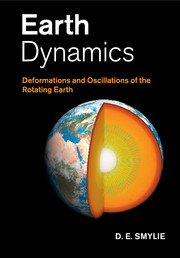Book contents
- Frontmatter
- Contents
- Preface and acknowledgments
- The book website www.cambridge.org/smylie
- 1 Introduction and theoretical background
- 2 Time sequence and spectral analysis
- 3 Earth deformations
- 4 Earth's rotation: observations and theory
- 5 Earth's figure and gravitation
- 6 Rotating fluids and the outer core
- 7 The subseismic equation and boundary conditions
- 8 Variational methods and core modes
- 9 Static deformations and dislocation theory
- Appendix A Elementary results from vector analysis
- Appendix B Properties of Legendre functions
- Appendix C Numerical Earth models
- References
- Fortran index
- Subject index
5 - Earth's figure and gravitation
Published online by Cambridge University Press: 05 March 2013
- Frontmatter
- Contents
- Preface and acknowledgments
- The book website www.cambridge.org/smylie
- 1 Introduction and theoretical background
- 2 Time sequence and spectral analysis
- 3 Earth deformations
- 4 Earth's rotation: observations and theory
- 5 Earth's figure and gravitation
- 6 Rotating fluids and the outer core
- 7 The subseismic equation and boundary conditions
- 8 Variational methods and core modes
- 9 Static deformations and dislocation theory
- Appendix A Elementary results from vector analysis
- Appendix B Properties of Legendre functions
- Appendix C Numerical Earth models
- References
- Fortran index
- Subject index
Summary
The study of Earth's figure and gravitation goes back to the very roots of the physical sciences. We begin with a description of its very interesting historical roots.
Historical development
Although ancient Greek and Egyptian philosophers and astronomers believed the Earth to be spherical and had made rough measurements of its size, the modern theory of the Earth's figure originates with the work of Newton. Using his newly developed laws of dynamics and gravitation, and making the remarkable assumptions that the Earth's figure is nearly an oblate spheroid (the surface generated by an ellipse revolved about its minor axis) and that the Earth behaves as a fluid, he was able to show that the ellipticity of figure is directly given by the ratio of centrifugal force to gravitational force at the equator. As a result of the neglect of the concentration of mass towards the Earth's centre, Newton's estimate of the ellipticity was more than 30% too large. However, the oblate spheroid continues as the figure of reference for geodesy, and the assumption of hydrostatic equilibrium remains as the basis of much of the modern theory. Perhaps Newton's most important contribution, though, was his unequivocal demonstration that any theory of the Earth's figure must take account of both its gravitation and its rotation.
Newton published his calculation in the first edition of the Principia in 1687, but the meridian arc length per angular unit of geographical latitude, as measured on European baselines, appeared to increase with increasing latitude, implying that the Earth was prolate rather than oblate. It was not until expeditions had been dispatched by the French Academy to Peru and Lapland that the matter was settled in Newton’s favour in the 1740s.
- Type
- Chapter
- Information
- Earth DynamicsDeformations and Oscillations of the Rotating Earth, pp. 323 - 385Publisher: Cambridge University PressPrint publication year: 2013



